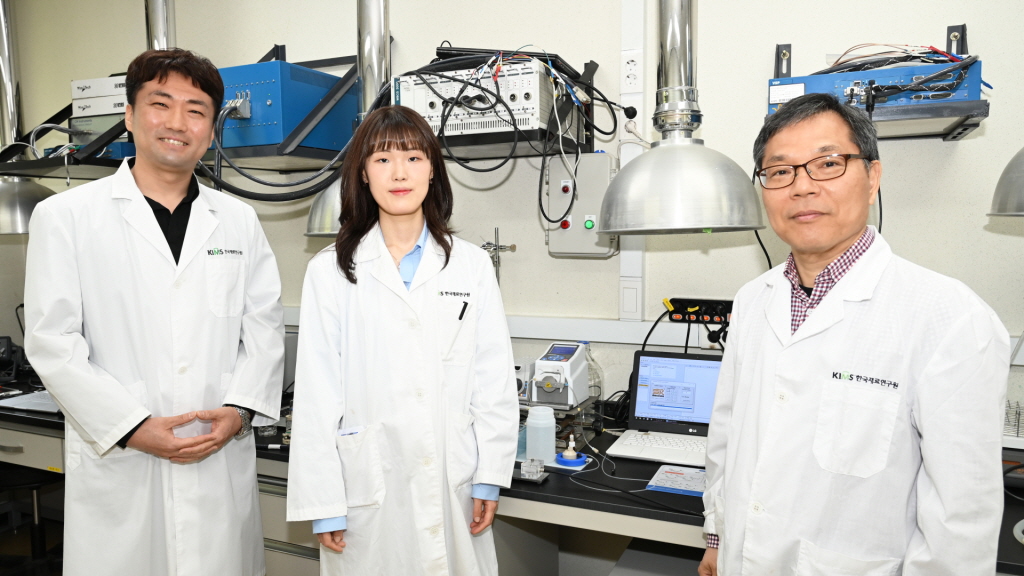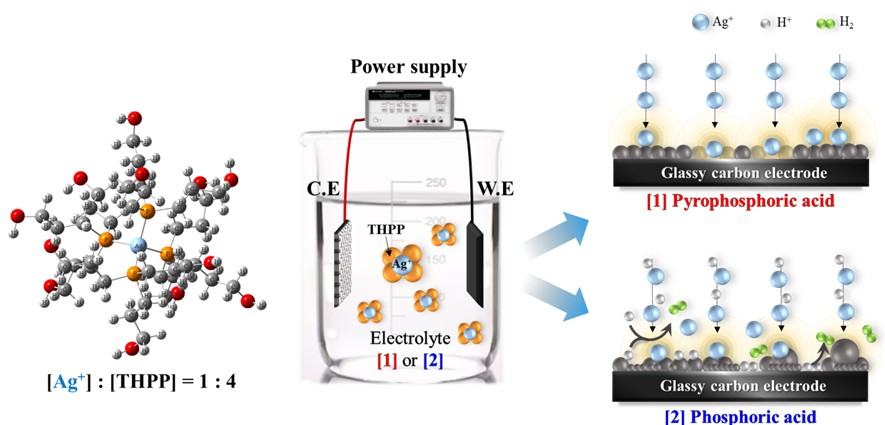한국재료연구원(KIMS, 원장 최철진) 에너지·환경재료연구본부 이주열, 김세일 박사 연구팀이 인(P, phosphorus) 화합물을 도금 핵심성분으로 활용한 친환경 은(Ag) 도금 기술을 세계 최초로 개발했다.

▲(왼쪽부터)김세일 선임연구원, 이수진 학생연구원, 이주열 책임연구원 등 연구진
인 화합물을 도금 핵심 성분 활용
고품질 은 박막 제조·공정 단순화
독성물질이 없이도 친환경 은 도금이 가능한 공정기술이 세계 최초로 개발되며, 향후 친환경 공정 및 글로벌 반도체 도금 기술 관련 시장에서 혁신을 이끌 것으로 기대가 모아진다.
한국재료연구원(KIMS, 원장 최철진) 에너지·환경재료연구본부 이주열, 김세일 박사 연구팀이 인(P, phosphorus) 화합물을 도금 핵심성분으로 활용한 친환경 은(Ag) 도금 기술을 세계 최초로 개발했다.
본 기술은 독성이 강한 시안화물(cyanide) 없이도 은 도금을 할 수 있게끔, 인 화합물 기반의 산성(acid) 도금 용액을 개발해 균일하고 안정적인 은 박막을 형성한 성과다.
은 도금은 반도체, 전자 부품, 회로기판 등에서 전기 신호의 전달 성능을 높이기 위해 반드시 필요한 공정이다.
기존의 은 도금 기술은 ‘시안화물’이라는 독성 물질을 사용해 환경과 안전 문제를 일으킨다.
또한 시안 도금액은 반도체의 정밀 패턴을 제작하는 포토리소그래피(photolithograpy) 공정에 적용할 수 없다는 큰 단점이 있다.
알칼리성의 도금액이 감광액(photoresist)을 녹이기 때문이다. 따라서 정밀한 공정을 하기 위해서는 산성 도금 용액을 필수적으로 사용해야 한다.
시안화물 없이 도금하는 방법(비시안화물 은 도금 기술)도 있다.
만면에 비시안화물 도금 기술은 산성 환경에서 수소 이온의 영향으로 은 이온이 침전되는 문제가 발생하며, 이로 인해 도금 용액이 불안정하고 균일한 은 도금이 어렵다.
도금 용액의 안정성을 향상하기 위해 다양한 첨가제를 넣는 탓에 공정이 복잡하다는 점도 단점이다.
이러한 문제로 인해 대부분의 비시안화물 은 도금 기술 개발은 산성이 아닌 중성이나 알칼리성 도금 용액 개발에만 치중됐다.
이번 연구성과는 산성 환경에서 시안화물과 첨가제 없이도 안정적으로 은을 균일하게 도금하는 기술이다.
연구팀은 포스핀 리간드(phosphine ligand)를 활용해 은 이온의 침전 없이 안정적으로 유지하고, 인 기반의 전해질 농도를 조절해 도금의 질을 높이는 최적 비율을 도출했다.
이를 통해 균일하고 강도 높은 은 도금층을 형성했다. 결과적으로 친환경성은 물론, 고품질의 은 박막 제조와 공정 단순화를 모두 충족하는 기술 구현에 성공한 것이다.
전 세계 산업용 도금 시장이 빠르게 성장 중이며, 특히 환경 규제가 강화되면서 친환경 도금 기술에 대한 수요가 높아지고 있다. 본 연구 성과는 반도체 패키징, 전자 부품 등과 더불어 의료기기나 광학 센서, 정밀 부품과 같은 고품질의 은 도금이 필요한 산업에도 적용이 가능하다. 또한, 해외 기술 의존도를 낮추고 국산 기술로 수출 확대를 이룰 수 있어 산업적 가치도 매우 크다고 할 수 있다.
연구책임자인 재료연 이주열 책임연구원은 “이 기술은 은 도금 공정에서 발생하는 환경 문제를 해결하는 것과 동시에 반도체 및 전자 부품 제조에 필요한 고품질의 도금까지 가능하게 만든다”며 “산업 현장의 혁신을 이끄는 계기가 될 수 있을 것으로 기대한다”고 말했다.
이번 연구는 산업통상자원부와 한국산업기술진흥원이 지원하는 한-독 국제공동기술개발사업의 일환으로 수행됐다. 연구 결과는 전기화학 분야의 세계적인 학술지 ‘일렉트로키미카 악타(Electrochimica Acta(IF:5.5, 제1저자: 이수진 학생연구원))’온라인 판에 지난 2월26일에 게재됐다. 또한 이와 관련한 국내 특허도 출원한 상태이다.

▲DFT 계산을 이용한 은 이온과 THPP간 착화형태의 분자구조 예측 및 전해질 별 은 도금층 전착 거동을 나타낸 그림

